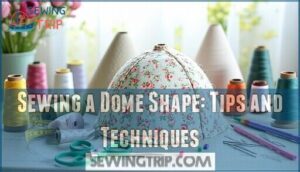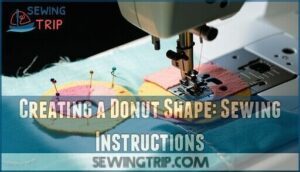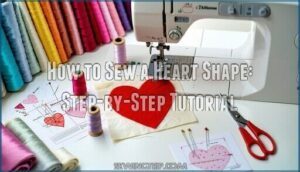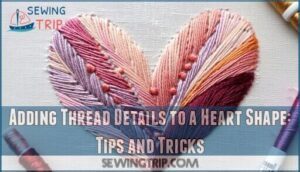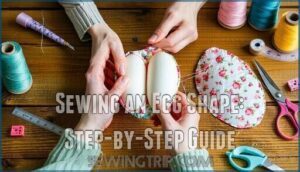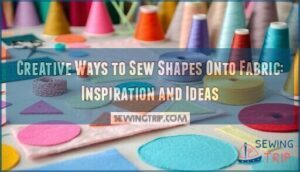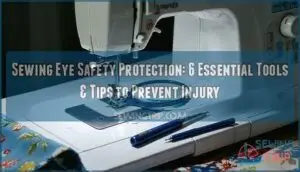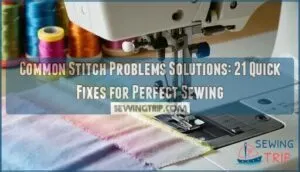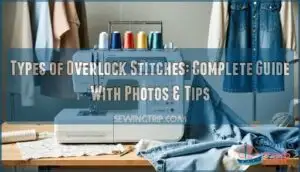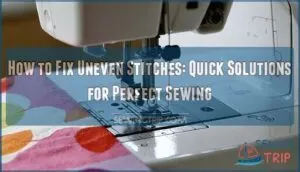This site is supported by our readers. We may earn a commission, at no cost to you, if you purchase through links.
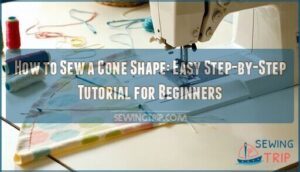 You’ll create a cone shape by cutting a sector from a circle of fabric, then sewing the straight edges together.
You’ll create a cone shape by cutting a sector from a circle of fabric, then sewing the straight edges together.
Start by drawing a circle on your fabric using a compass or string method, then cut out a pie-slice portion—the bigger your slice, the wider your cone.
Pin the straight edges together with right sides facing, stitch with a ¼-inch seam allowance, and press flat.
The trickiest part isn’t the cutting or sewing—it’s getting that perfect point without puckering.
Master this fundamental technique and you’ll discover dozens of creative projects that’ll have everyone asking for your secret.
Table Of Contents
- Key Takeaways
- How to Sew a Cone Shape: Step-by-Step Tutorial
- Top 5 Techniques for Adding Increases in Crocheting a Cone Shape
- Sewing a Cylinder Shape: Step-by-Step Guide
- Sewing a Dome Shape: Tips and Techniques
- Creating a Donut Shape: Sewing Instructions
- How to Sew a Heart Shape: Step-by-Step Tutorial
- Adding Thread Details to a Heart Shape: Tips and Tricks
- Sewing a Shape Gown: Design Ideas and Techniques
- Sewing an Egg Shape: Step-by-Step Guide
- Creative Ways to Sew Shapes Onto Fabric: Inspiration and Ideas
- Frequently Asked Questions (FAQs)
- Conclusion
Key Takeaways
- You’ll start with a semicircle pattern where the radius equals your desired cone height, then overlap the straight edges to control the cone’s width and angle.
- You’ll need sturdy fabrics like cotton or canvas with interfacing to prevent collapse and maintain structure, especially at the crucial pointed tip.
- You’ll sew with a ¼-inch seam allowance, pin right sides together, and turn the cone right-side out carefully to achieve that perfect point without puckering.
- You’ll master this fundamental technique to create dozens of projects from wizard hats to lamp shades, transforming simple fabric circles into dimensional masterpieces.
How to Sew a Cone Shape: Step-by-Step Tutorial
Mastering fabric selection sets the foundation for your cone-shaped creation, whether you’re crafting Valentine’s treats or party favors.
Choose sturdy materials with interfacing like Craft-Fuse for structure, then determine your cone height to calculate the semicircle dimensions.
Looking at the tone and style of the paragraph about choosing sturdy materials and calculating cone dimensions, here’s a short blockquote:
Master your measurements first—precision in planning prevents sewing frustration later.
Cut your fabric precisely, sew with a 1/4-inch seam allowance, and turn right-side out for that perfect point.
Proper fit can be achieved by consulting size charts before cutting your fabric.
Experiment with angle variations and closing techniques to achieve your desired shape—you’ll discover this fabric cone tutorial transforms simple materials into delightful handmade treasures.
Top 5 Techniques for Adding Increases in Crocheting a Cone Shape
While mastering fabric cone construction lays the foundation, crocheting cones requires different increasing techniques to achieve that perfect tapered shape.
You’ll need to understand how strategic stitch placement transforms a flat circle into a dimensional cone.
Here are five powerful techniques that’ll elevate your crochet cones:
Single Increase Per Round creates narrow, elegant cones perfect for unicorn horns.
Start with six stitches, then add one increase each round for gradual expansion that won’t look wonky.
Multiple Increases Per Round builds broader bases faster.
Adding two or three increases per round works brilliantly for Christmas trees or witch hats where you want pronounced flare.
Increases Every Other Round gives you breathing room between complex rounds.
This technique offers controlled, moderate expansion that’s perfect for beginners still mastering stitch counting.
Extended Stitch increases using double or treble crochet add vertical height while maintaining smooth curves.
Your cone shape develops both width and elegant proportions.
Front Loop and Back Loop increases provide precise control over expansion while preserving stitch definition.
This technique prevents that dreaded "lumpy" appearance that plagues many crochet cones.
- Picture a delicate ice cream cone with perfectly smooth sides
- Visualize a witch’s hat with dramatic flair at the base
- Imagine a unicorn horn with razor-sharp precision at the tip
These increasing techniques transform your fabric cone tutorial knowledge into three-dimensional crochet mastery.
You can also use these techniques to make various amigurumi shapes.
Sewing a Cylinder Shape: Step-by-Step Guide
Creating something cylindrical might seem tricky, but it’s surprisingly straightforward once you understand the basics. Start with fabric selection – cotton works wonderfully for beginners since it’s forgiving and holds its shape well.
Cotton’s forgiving nature makes cylindrical sewing surprisingly manageable for beginners seeking reliable results.
Your measuring accuracy matters here: calculate the circumference by multiplying your desired diameter by 3.14, then add seam allowances. Cut one rectangle for the sides and two circles for the ends.
Master your joining techniques by sewing the rectangle’s short ends together first, creating a tube. Pin each circle to the tube’s ends, clipping seam allowances to ease curves. These pattern adjustments and seam finishes create professional-looking cylinder shapes every time.
For projects using heavier fabrics, remember that fabric experiences more drag on the sewing table.
Sewing a Dome Shape: Tips and Techniques
You’ll find that sewing dome shapes opens up a world of three-dimensional creativity beyond basic fabric cone tutorial projects.
When working with Dome Fabric Choice, select medium-weight cotton or linen that holds structure while remaining workable. Stabilizer Usage becomes essential for maintaining the dome’s rounded form—apply interfacing to prevent sagging. Master Curved Seams by clipping corners and easing fabric around curves for smooth results.
Many sewers find inspiration and support through online sewing communities.
Consider these dome variations for your next fabric cone craft:
- Inverted Domes that create bowl-like shapes perfect for decorative bowls or lampshades
- Quilted domes with batting sandwiched between layers for plush cushions and toys
- Multi-panel geodesic designs using triangular pieces for complex architectural forms.
Dome Embellishments like decorative stitching or appliqué transform simple shapes into stunning centerpieces for any how to sew cone project collection.
Creating a Donut Shape: Sewing Instructions
Something truly magical happens when you transform two circular fabric pieces into a three-dimensional donut shape.
Start by cutting two circles with central holes, ensuring your rotary cutter creates clean edges for professional results. Pin the curved seams carefully, clipping as needed to prevent puckering during assembly.
Use stretch stitches when sewing donut shapes, allowing fabric movement while maintaining structural integrity. Proper machine threading guarantees perfect stitches.
Your fabric cone tutorial skills translate perfectly here, as precision in measuring inner and outer diameters determines success. Consider shape variations by adjusting hole sizes, and remember that mastering cone pattern sewing principles applies beautifully to donut construction techniques.
How to Sew a Heart Shape: Step-by-Step Tutorial
Turn your fabric into charming heart appliqués by folding a fabric square diagonally and stitching along the curved edges.
This simple technique opens up endless possibilities for Valentine crafts and heart embellishments that’ll make your sewing projects shine.
- Fabric Selection: Choose cotton or felt for beginner-friendly heart variations that hold their shape well
- Stitching Curves: Guide your needle smoothly along the rounded edges, maintaining consistent seam allowances
- Heart Appliqués: Layer different sized fabric hearts for dimensional effects on quilts or garments
- Decorative Edges: Add zigzag or scallop stitches around heart embellishments for extra flair
- Valentine Crafts: Create multiple hearts in coordinating colors for seasonal decorating projects
These sewing techniques translate beautifully to other sewing shape tutorials, including cone construction. Exploring online sewing communities can provide additional inspiration for embellishment techniques.
Adding Thread Details to a Heart Shape: Tips and Tricks
Transform your heart shapes into stunning works of art by mastering thread embellishment techniques that’ll make your projects shine.
These decorative methods work beautifully whether you’re sewing heart shapes as standalone pieces or incorporating them into larger projects like sewing cone shapes. A key to success involves understanding thread and needle compatibility to prevent issues.
Essential Thread Detail Techniques:
- Thread Painting Hearts – Layer colorful threads to create painterly effects and gradients
- Embroidered Heart Accents – Add French knots, satin stitches, and chain stitches for texture
- Quilting Heart Motifs – Use echo quilting or stippling around heart edges for dimension
- Heart Applique Detailing – Secure fabric hearts with blanket or zigzag stitches
- Decorative Stitch Hearts – Experiment with your machine’s built-in decorative patterns
Sewing a Shape Gown: Design Ideas and Techniques
How can you elevate a simple cone shape into an elegant gown that turns heads? Creating sewing shape gowns requires mastering several key techniques that transform basic patterns into stunning silhouettes.
Start with strategic fabric selection—structured materials like taffeta and organza maintain shape better than cotton, while synthetic blends offer durability and elegant sheen. You’ll find that 70% of shape gowns use these blends for good reason.
Master different gown silhouettes by experimenting with pattern alterations. Princess seams contour your body beautifully, while asymmetrical cuts add modern flair. When sewing cone shape patterns, remember that proper fit adjustments make all the difference—they can reduce construction errors by 30%.
Embellishment techniques shouldn’t be afterthoughts. Beadwork, sequins, and delicate embroidery add opulence, while strategic pleating and gathering create volume without weight. Think of your gown as a canvas where cone shaped pattern elements become architectural features. For delicate fabrics, consider using couture seam finishes to prevent fraying. Don’t forget structural support—interfacing prevents sagging in 85% of formal wear, and proper boning maintains those gorgeous curves you’ve worked so hard to create.
Sewing an Egg Shape: Step-by-Step Guide
Moving from structural garments to three-dimensional forms, sewing egg shapes opens new creative possibilities. You’ll master curved seaming while creating charming decorative pieces or functional items like pincushions.
Start with Fabric Choice – cotton or linen work beautifully for stability. Cut two identical oval pieces, adding Seam Allowance around edges. Pin carefully, then stitch slowly around curves using Shaping Techniques like easing fabric gently. Leave small opening for turning. Filling Options include polyfill or rice for weight. For raw edges, consider using overlock stitches to prevent fraying. Finish with hand-stitching the opening closed, then explore Decoration Ideas like embroidered details.
Five Essential Steps for Perfect Egg Shapes:
- Pattern precision – Your oval template determines everything
- Gentle curves – Rush the seaming, ruin the shape
- Strategic stuffing – Too much creates lumps, too little looks sad
- Invisible closure – Ladder stitch saves the day
- Creative finishing – Plain eggs are just potential waiting
These sewing shape techniques transform flat fabric into dimensional art, proving sewing egg shapes can be both relaxing and rewarding for your sewing shape exploration.
Creative Ways to Sew Shapes Onto Fabric: Inspiration and Ideas
You’ve mastered sewing cone shapes, but now it’s time to explore exciting ways to incorporate various shapes into your fabric projects. Whether you’re creating decorative elements or functional designs, these sewing shape techniques will transform your work from ordinary to extraordinary.
Shape Appliqué Ideas offer endless possibilities for personalizing your projects. Start with simple geometric forms, then progress to more complex designs using fabric manipulation techniques. Textile Collage methods let you layer different materials for stunning visual effects.
| Technique | Best For | Skill Level |
|---|---|---|
| Basic Appliqué | Beginners | Easy |
| Fabric Fusion Art | Mixed media projects | Intermediate |
| Reverse Appliqué | Detailed designs | Advanced |
| Embellishment Techniques | Adding texture | All levels |
Patterned Fabric Shapes work beautifully when you’re combining multiple sewing techniques. For added flair, consider using heat transfer vinyl for unique appliques. Try mixing prints with solids, or experiment with different textures like velvet against cotton. Remember, there’s no "wrong" way to be creative—sometimes the most unexpected combinations produce the most stunning results in your sewing cone shape projects and beyond.
Frequently Asked Questions (FAQs)
How to form a cone shape?
Here’s your secret: start with a semicircle, then overlap the straight edges to create your perfect cone.
Cut fabric with doubled measurements, sew edges together, and turn right-side out for instant three-dimensional magic.
How to cut a perfect cone shape?
Start with a semicircle pattern where the radius equals your desired cone height.
Cut the semicircle precisely, then overlap the straight edges to form the cone shape, adjusting the overlap to control the cone’s width and angle.
Which fabrics work best for cone construction?
Like choosing the perfect partner for a dance, selecting sturdy cotton or canvas fabrics creates reliable cone shapes.
You’ll want medium-weight materials that hold structure without being too stiff—think quilting cotton with interfacing for beginners.
How to prevent cone points from collapsing?
You’ll want to reinforce that essential tip with interfacing like Craft-Fuse 808 or foam stabilizer before sewing.
Push out the point completely when turning right-side-out, then stuff lightly with batting or fill.
What seam allowances should I use for cones?
Use a ¼-inch seam allowance for fabric cones.
This standard measurement provides enough material for secure stitching while preventing bulk at the pointed tip that could cause distortion or difficulty turning.
Can I make cones without interfacing or stabilizer?
Like a shirt without a collar, cones can work without interfacing, but they’ll lose structure and stability.
You’ll get droopy, floppy results that won’t hold their shape well, especially with lightweight fabrics.
How to calculate fabric needed for different cone sizes?
Calculate fabric by determining your cone’s height and base circumference.
For a 6-inch tall cone with 4-inch base, you’ll need roughly a 12-inch diameter semicircle.
Double the height for diameter, then add seam allowances.
Conclusion
Like a compass pointing toward mastery, learning how to sew a cone shape opens the door to countless creative possibilities.
You’ve conquered the fundamentals—from cutting your perfect sector to achieving that flawless point without frustrating puckering.
Remember, practice makes progress, so don’t worry if your first cone isn’t Pinterest-perfect.
With these techniques in your sewing toolkit, you’re ready to tackle everything from costume wizard hats to elegant lamp shades, transforming simple fabric circles into dimensional masterpieces that’ll impress everyone, and help you achieve flawless results.


